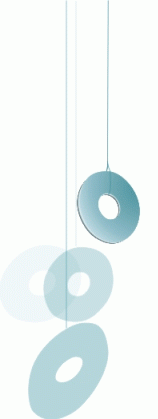

 |
 |
|||
|
Incredible Ladies
Articles Columns/Blogs
Word of Mouth |
Chest - Exercise Guide for a Killer Cleavage!
Well, given that I don't have a cleavage - that is a great one. Unfortunately this area gives in quickly when losing weight and getting older doesn't help either. So far not a lot of people know my way of cheating. I once had a chat with a friend who is in her late 20s about aging and the way things tend to go south. She was astonished that I claimed this to be something I have experience in. So I told her that what she saw was not the usual material that nature uses to form a cleavage, but muscle. When she still wouldn't believe me I made her touch - and she shrieked back... So whether you are a flat chested chicken or a chick come to age, a bit of muscle in that particular area does work wonders, the rest is ... to use Trinny's way of putting it (she is the flat chested chick from T&S) ... the rest is to be done by 'gather and thrust'. The chest muscle (pectoralis) is a big one consisting of several parts - thus it needs more than one exercise to train it properly.
Exercise Guide for a Killer Cleavage!For the chest there are loads and loads of exercises, what is good as it keeps the training interesting, but it is a bit confusing as well. So I will cut down to only four in this place. They are the ones I love doing and which work best for me. I like to distinguish between training the main muscle and exercises which work as a combination between chest, shoulders, arms and neck. The shoulder is one of the most sophisticated joints and all those muscles meet there. So it is fair enough to have exercises which makes them work together, despite the fact that usually the aim in Bodybuilding is to isolate muscles in an exercise as much as possible. This for me is the big exception. Exercises for training the main muscle - get the cleavage
Exercises for bringing it all together
Numbers, Numbers, and a few things more! |
||||||||||||||||||||||||||||||||||||||||||||||||||||||||||||||||||||||||||||||||||||||||||||||||||
| Muscle size: |
|
||||||
| Number of exercises: |
|
||||||
| Order: | Work from big to small muscles, meaning in the above order. | ||||||
| Importance: | High: for 1 and 2
If you are short of time or a station is occupied then you can do either cable fly or pull over. They tackle about the same muscles from a different angle and put the focus a bit differently. You can as well alternate between sessions. |
||||||
| Number of sets: | These differ with each exercise and will be listed in the exercise description.
If in doubt stick with the Three/12 Rule. |
||||||
| Number of repetitions: | These differ with each exercise and will be listed in the exercise description.
If in doubt stick with the Three/12 Rule. |
||||||
| Duration: | 45 min | ||||||
| Breathing: |
|
||||||
| Progress: | This differs with each exercise and will be listed in the exercise description.
If in doubt stick with the Three/12 Rule. |
||||||
| Train together with: | Back Arms |
||||||
| DON'T train with: | Shoulders |
![]()
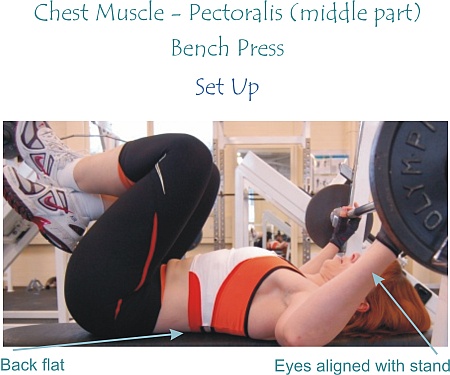
![]()
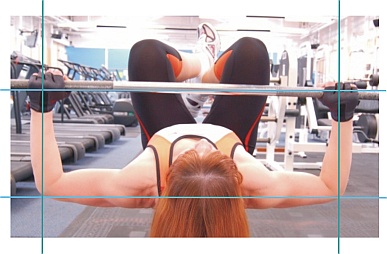
How to determine the width of the grip?
Hold the upper arms parallel to the floor and bend the lower arms up.
With the bar held in your hands it should form a rectangle

Once the weight is taken out of the stand, the back tends to arch in order to counter the weight.
I have a round back anyway and to avoid strain I trained to keep the balance even with heavy weights while holding the legs up. This way it is easier to keep the back as flat on the bench as possible.
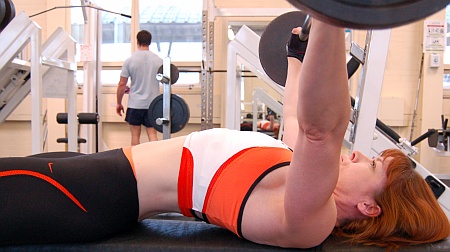
The other extreme is to put the feet on the ground. This is a very stable posture. However, especially when concentrating on pressing up a heavy weight, the back gets easily forgotten and I have seen people even lifting the rear off the bench and starting to trip around with their feet while pressing, causing enormous strain on the back.
And this actually is a way of cheating. In arching the back the angle between the arms with the weight and the upper body changes and becomes smaller. This way the lower part of the pectoralis and the serratus muscles are called in for help which makes it easier to push up the weight.
That wouldn't be a problem if the exercise weren't designed to train the middle bit of the pectoralis. To get the other muscles trained there are other exercises which don't kill the back.
A good middle way for the position of the feet is to put them flat on the bench. That gives stability and helps to keep the back flat.
And here are some numbers:
| Bench press | |||||||||||||||||||||||||||||||
| Number of sets: |
|
||||||||||||||||||||||||||||||
| Number of repetitions: | Warm up 1: Just the bar 15 - 20 reps
This is more to stretch, to get settled on the bench, to feel if there is some leftover muscle ache. Do the first ones very slow and feel the stretch of the chest muscle. Warm up 2: chose a weight where you can do 10 reps easily (70-80%). This is to get a feeling for weight, how good your are at that day, to check if the muscles are working smoothly under weight - basically to tell them that they are 'ON'. Now it becomes complicated with some 'if and then'. If 'warm up 2' feels easy Set1 - Set?: - as heavy as possible, probably even raising the weight. If you can do 3-5 reps per set, then do as many sets that alltogether you have 10 reps. Do 1 more set with a bit lighter weight to finish the muscle off. If you did less then 3 reps than reduce weight in the next set, and so on. If warmup 2 feels heavy
In bench press I go for 100% whenever I have a spotter. Only on days where I'm training alone I take it easy what is a good recovery for the muscle. When training on the limits like this, be prepared to skip one or even two sessions every 2 month or so to avoid overtraining. |
||||||||||||||||||||||||||||||
| Duration: | 20 - 25 minutes you will need rather big breaks to get the heart rate down. Walk around a bit. You may need a bit more time when you are training with a partner and slipping into each other's breaks. |
||||||||||||||||||||||||||||||
| Progress: | 10 is absolute cut off.
Using the second warm up to explore the shape of the day and then either going for the purple or the orange version enables me to acknowledge that I'm not at the hight of my performance every day, but nevertheless gives me the best workout I can have. |
||||||||||||||||||||||||||||||
![]()
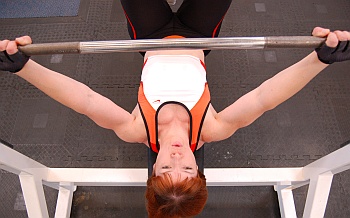
Get yourself in position and grab the bar at the right width as described above.
Push slightly against the bar to test the weight, and to test the grip of the hands - sometimes some skin of the palm gets pinched in what can be very hurtful.
Take a deep breath in, push the bar out of the stand while breathing out.
Balance it out and breath as you like
Take another deep breath in while lowering the bar down to your chest. It should touch the skin only 'just' ...
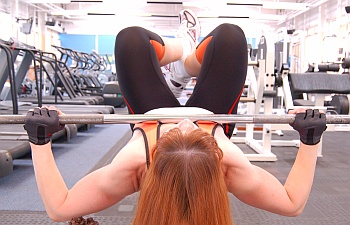
... and then push it out while breathing out.
You will have to keep the breath for a brief moment to have maximum power build up by the time the upper arms are parallel to the floor. That is when the weight feels the heaviest.
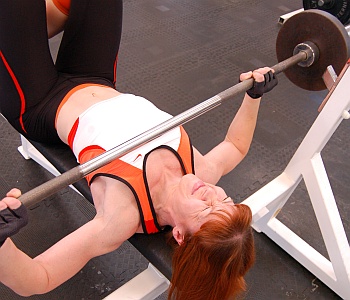
Above that you will have to breathe out as controlled as you move the weight up. It is absolutely appropriate to do so with some huffing, puffing, or screaming. You have to get rid of the pressure that you've built up in the first part of the up-movement in a very controlled way. Otherwise you won't reach maximum performance and you might even harm yourself.
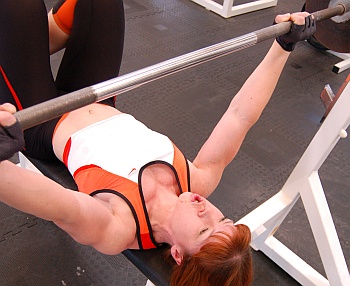
Bench press is a rather technical exercise and breathing is essential. You should only move on to really heavy weights when you are feeling comfortable with the breathing technique.
On a side note: The rhythm is rather slow, so if you have the opportunity to have the music switches off or tuned down, than do that. It is rather hard to deliberately tune your heart rate down so that you can sustain a slow and long breathing rhythm when music at 180 beats is messing with your head.
This is true for all of the Bodybuilding. Music is OK, but it should not force you into a rhythm that goes against your training needs. Bodybuilding is about concentration and meditation. The energy comes from within yourself as opposed to aerobic classes where the music is supposed to raise your heart rate and thus give you a drive you wouldn't have otherwise.
|
Pictures by Babul
|
To come soon
![]()
Events
Norwich Half Marathon 08
Race for Life 2008
Rowing League 07/08
Imola: MH 10K, 07
Rika: Race for Life 07
![]()
General
Ballet for Oldies
Training Plan 2008
Boxing vs. Kickboxing
What Sport to Choose?
Tummy
An Experiment
Good Use for Chocolate
![]()
Being Strong
Women and Strength?
Why Muscles?
Lucky Number 12
Shoulders
Legs
Chest
Ladies are Stronger!
![]()
| Feedback |
Copyright 2007 incredible-ladies.com
|
Author: Rika
|